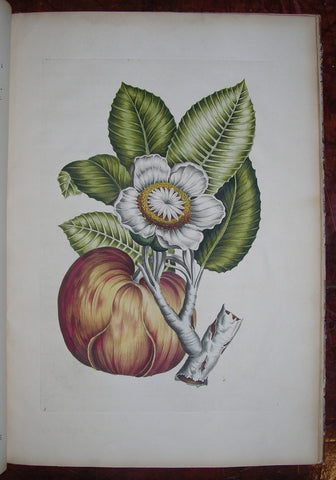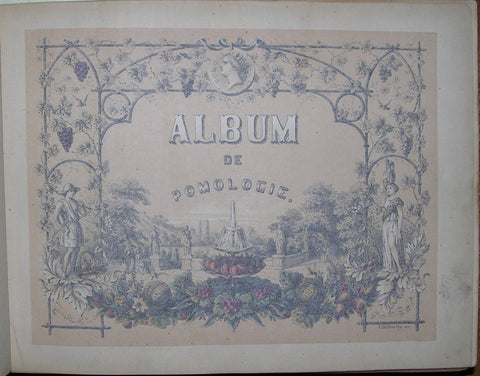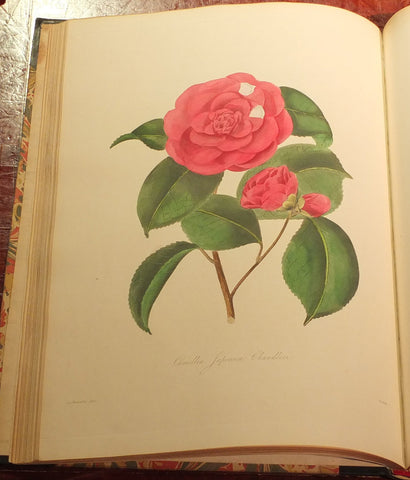Sir John Hill (1714-1775), A Decade of Curious and Elegant Trees and Plants, Drawn After Specimens Received from the East Indies and America.
Sir John Hill (1714-1775)
A Decade of Curious and Elegant Trees and Plants, Drawn After Specimens Received from the East Indies and America.
London: Printed For the Author, 1773
Folio (19 x 13 inches). Ten exceptionally fine engraved and numbered botanical plates with original hand-colour in full. 19th-century half tan calf, marbled paper boards (a bit scuffed at the extremities, hinges weak).
Provenance: with the ink library stamp of Francis Caesar de Tellier, Marquis de Courtanvaux (1718-1781), natural scientist, on the title-page and the verso of the last plate.
First edition, and RARE, by the author of the groundbreaking The Vegetable System. Or, The Internal Structure, and the Life of Plants, 1770-1775 which was "of great importance because it gave for the first time in the vernacular a comprehensive treatment of the plant kingdom, on a lavish scale ... adopting the Linnaean generic names and introducing binary nomenclature" (F.A. Stafleu Linnaeus and the Linnaeans, Utrecht: 1971, p. 210).
The magnificent plates which illustrate the exotic plants so elegantly described, include:
The Cornucopian Shrub, Copianthus Indica" "whose hollow Combs play in the wind, and dance to its least motions, in the sandy deserts of the East Indies";
The Upright Lima Lilly, Alstromeria Pelegrina: "This elegant Plant flowered at Bayswater in May 1771; having been raised from Seeds received from Spain: but its native country is Peru. The Marquis del Ensenada, desirous of seeing the Root of the Lobelia cure Venereal Diseases, applied to me for a quantity. I had permission to direct John Bartram to collect it in America: and among many Seeds, sent in return from Spain, were those which gave this Plant"
The Rose-Apple, Dillenia Indica: "The Tree was more than fourscore feet in heighth, from which my friendly Armenian crop'd this loaded Bough; whose Fruit answer'd the exalted dignity of the Flower; and both well became the firm, and solid aspect of its glossy Leaves... It grows in the high forests of Malabar, and elsewhere in the East Indies; and was covered with Flowers and ripe Fruit at once, at Christmas"
Sensible Wood-Sorrel, Oxalis Sensitiva: "The Indians tell us of a living Plant: and their Priests and Sages speak of it as a miracle; nay, they pretend also to work miracles by its means: raising the dead; as well as giving motion to limbs struck with palsies. The Botanical writers have been at all times acquainted with it; but so perfect Specimens, or so full and rational account of its nature, has not come to Europe, as that which gave origin to the present history"
Venus Flytrap, Dionaea Muscipula "When my Pupil, William Young, to whom the King is pleased to allow a pension, for his Botanical researches in America, first told our wondering gardeners that he had seen the Dionaea with Leaves three inches long; 'twas look'd on as a fable: but it is prv'd a truth, by Specimens, which were gather'd this last summer, on a bog in Pensylvania: and from one of which the present Figure is drawn"
Crimson Mountain Ebony, Bauhinia Purpurea: "A Tree of twenty feet high grew from the cranny of a naked rock in Malabar, where dry sand only served to nourish it. Its tender Branches spread to a wide circumference, play'd in the wind, and toss'd a million of these bright Flowers about; glittering in the sun, and almost dazzling the Indian's eye, who was dispatch'd to pluck a Branch"
The Lustre Vine, Ceropegia Candelabrum: "A Large and lofty forest in India, thick covered at the top, but free for walking below, seem'd hung with little lustres; glowing with a living crimson, and dancing in the wind. What most astonish'd the observer was, that every tree produced them: and be what would the kinds, however different in their nature, these most amazing Flowers yet hung from all
Yellow American Water-Lilly, Nymphea: "There is not perhaps in the Vegetable nature, a Plant more elegant, and singular than this American. The present Specimen was drawn up from the bottom of a deep lake in North America; deep at once, and clear; where a multitude of these Plants rose from the clean, white, sandy bottom; and not affecting to ascend into the region of the air; flower'd in profusion, and still security, at thirty feet under the living crystal. If Vegetables have sense, (as who shall say they have not something approaching towards it,) this Plant must enjoy the pure element in which it lives; and the secure rest in which it blooms, in some uncommon manner"
Flaggon Leaf, Nepenthes Destillatoria: "If faithful records had not, in this instance, the testimony of the senses to confirm them, they scarce would obtain credit: we should find it hard to believe there was a Shrub whose Leaves bore chalices of limpid and healthy water; but that the Leaves and Flaggons are before us: yet are all anture's wonders chain'd together: they rise like the steps of some august structure; regular, and equidistant: nor is there ever a great gap between them: not even here; for we may trace the progress of simples Leaves gradually up to these most wonderful... It grows in the driest parts of the East Indies"
Orange Grape, Michelia Champaca: "Upon the outskirts of a vast forest, that cloaths a hill of slow ascent in the East Indies; and in a place where there met together the waters of three little springs, that drop from rock to rock among the Stumps and Stems of Trees; appear'd a grove of verdant, tho' not lofty Bushes; covered with golden Grapes"
Little is known of John Hill's "early years before he was apprenticed to the London apothecary Edward Angier in 1730–31. One source current until the late nineteenth century held that he was a strolling player from 1730 to 1735, but this is unsubstantiated. However, Hill's fascination with the theatre is definite, vying with his interest in botany as chief among his lifelong preoccupations. In 1738 he started collecting specimens for Lord Petre, [then] worked as an apothecary in a shop close to the Strand, London, and during the years 1739–40 the second duke of Richmond, Lennox, and Aubigny commissioned Hill (probably as a result of an introduction from Petre) to collect specimens for him from England and Wales... During this time in London, Hill began seriously to promote and expand his interest in natural science, becoming acquainted with significant naturalists and fellows of the Royal Society such as Martin Folkes, Sir Hans Sloane, Henry Baker, William Watson, and James Parsons. Hill's scientific publications consequently began to grow and multiply...
"1757 saw his attentions turn once more to the sciences, with Eden, or, A Compleat Body of Gardening and The Sleep of Plants, and Cause of Motion in the Sensitive Plant. Hill finally secured the patronage of Lord Bute and published a long list of titles, including: The Construction of the Nerves, The Virtues of Wild Valerian, An Idea of a Botanical Garden in England, The Management of the Gout, The History of Insects, A Method of Producing Double Flowers, and The Gardener's New Calendar. All were published in 1758. He also made another sally at entering the theatre world with his farce The Rout, which proved to be prophetically titled, with Garrick breaking off for ever with Hill in 1759. In that year too, at the instigation of his patron Bute, Hill began his magnum opus, The Vegetable System (1759–75), a work which eventually ran to twenty-six volumes. The work cost Hill a considerable amount of money, some of which he recouped through the sale of herbal medicines such as ‘the essence of water-dock’, ‘tincture of valerian’, and ‘pectoral balsalm of honey’. Other botanical titles of 1759 included Virtues of Honey, Usefulness of Knowledge of Plants, Proliferous Flowers, and A Practice of Gardening. In this year too he published his Cautions Against the Immoderate Use of Snuff, a curiously prescient tract which associates tobacco with cancerous growths. Hill also bought a property in Bayswater, London, and began to help Bute to lay out Kew Gardens. His Flora Britanica, published in the same year, was the first Linnaean flora of Britain. Although volumes one and two of The Vegetable System were published in 1761, Bute was becoming less and less involved in the project as his star rose (to prime minister in 1762) and fell (in 1763, when he was out of office). As a result of the impact of The Vegetable System on the continent, Hill found himself corresponding with European scientists such as Haller and Gesner. He became ill in 1764, perhaps from the effects of gout and dropsy; his Centaury, the Great Stomachic, a book of herbal remedies, followed in 1765, and in 1766 he published Hypochondriasis, a Practical Treatise on the Nature and Cure of that Disorder.
"In 1773, despite being handicapped by a return of ill health, Hill nevertheless managed to publish volumes twenty-one to twenty-two of The Vegetable System, in addition to Twenty-Five New Plants, A Decade of Curious and Elegant Trees, and Plain and Useful Directions for those who are Afflicted with Cancers. In 1774 he was awarded the order of Vasa by Gustavus III of Sweden, which honour was conferred at the English court some time between 1 and 10 June. The last year of Hill's life, 1775, saw the publication of the final volumes of The Vegetable System, in addition to Inquiries into the Nature of a New Mineral Acid Discover'd in Sweden and Circumstances which Preceded the Letters of the Earl of Mexborough. (Barry O'Connor for DNB).
From the distinguished library of Francis Caesar de Tellier, Marquis de Courtanvaux, who initially embarked on a military career until ill-health forced him to resign in 1745. He subsequently took up the the study of the natural sciences, and was elected to the Academie des Sciences in 1764. He published Journal du voyage de M. Le Marquis de Courtanvaux, sur le Fregate l'Aurore, pour essayer par ordre de l'Academie, plusieurs instrumens relatifs a la Longitude. Paris: Imprimerie Royale, 1768, as his report of a voyage in the frigate l'Aurore - a vessel that Courtanvaux fitted out at his own expense to allow for the accurate assessment under everyday conditions of the various competitors for the prize offered by the Academie (for the first successful method of accurately measuring longitude)" (Norman 1335). Nissen BBI 878; Great Flower Books, p.59; Stafleu TL2 2775; Henry 804.
We Also Recommend

















